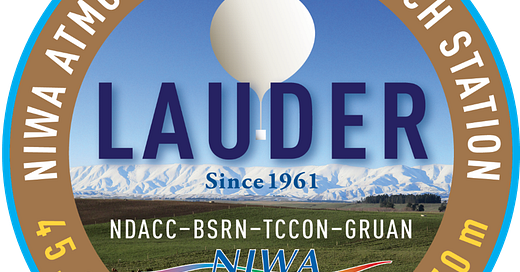My field of atmospheric science is littered with TLAs (Three Letter Abbreviations) and TFLAs (Three-or-Four Letter Acronyms), so I include here a glossary of terms and abbreviations to help guide you through that morass. Unfortunately, the character set that’s currently available on substack does not include subscripts or superscripts. to avoid ambiguity below, I’ve used the “^” character to represent superscripts.
Aerosol Suspension of particles in a gas
BSRN Baseline Surface Radiation Network
CFC Chlorofluorocarbon (used in refrigeration, e.g., CFC-11)
DIAL Differential absorption lidar
DOAS Differential optical absorption spectroscopy (sorry about that).
DSIR NZ’s Department of Scientific and Industrial Research (until 1992)
DU Dobson Unit, for measuring ozone
EEAP UNEPs’ Environmental Effects (of ozone) Assessment Panel
ESA European Space Agency
IDL Interactive Data Language (computer data-processing software)
IR Infrared radiation, (at wavelengths longer than 700 nm, or 0.7 µm)
GHG Greenhouse gas that absorbs IR (e.g., CO2, CH4, N2O)
GPS Global Positioning System
GWP Global Warming potential, relative to CO2
JPL Jet Propulsion Laboratory, Pasadena, USA
LIDAR Light direction and ranging (optical equivalent of RADAR)
µm Micron (10^-6 m), unit of wavelength in the visible and IR regions
nm Nanometre (10^-9 m), unit of wavelength in the UV and visible regions
nmol/l Nanomoles per litre, where 25(OH)D > 50 nmol/litre is optimal
NASA USA’s National Aeronautics and Space Administration
NCAR USA’s National Center for Atmospheric Research, Boulder Colorado
NIWA NZ’s, National Institute of Water & Atmospheric Research (from 1992)
NOAA USA’s National Oceanic and Atmospheric Administration
NOx Oxides of nitrogen (including NO2 and NO)
ODP Ozone Depletion Potential, relative to CFC-11
ODS Ozone Depleting Substance (e.g., CFC-11)
PMR Pressure modulator radiometer
ppm Parts per million by volume
ppb Parts per billion by volume
ppt Parts per trillion by volume
PSSC Physical Science Study Committee (of USA in the 1960s)
SED Standard Erythemal Dose of UV exposure (100 J/m^2 of UV-Ery)
TUV Tropospheric Ultra Violet. A computer program to calculate UV
USP University of the South Pacific
UNEP United Nations Environment Program
USDA United States Department of Agriculture
UV Ultraviolet (radiation)
UV-A UV radiation falling within the wavelength range 315 to 400 nm
UV-B UV radiation falling within the wavelength range 280 to 315 nm
UV-C UV radiation falling within the wavelength range 100 to 280 nm
UV-Ery Erythemally-weighted (i.e., sun-burning) UV
UVI UV index, a scale for sun-burning UV, from 0 to ~25 on Earth
Visible Radiation from 400 to 700 nm that can be detected by the human eye
WHO World Health Organisation
WMO World Meteorological Organisation
ZMR Zeeman Modulator Radiometer
25(OH)D Calcidiol, a diagnostic marker for vitamin D in blood serum (nmol/l)

A Lauder decal featuring acronyms aplenty


